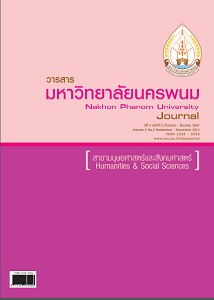การจัดการความขัดแย้งของผู้บริหารสถานศึกษา สังกัดสำนักงานเขตพื้นที่ การศึกษาประถมศึกษาบึงกาฬ
Main Article Content
บทคัดย่อ
การวิจัยครั้งนี้มีวัตถุประสงค์เพื่อ 1) ศึกษาวิธีการจัดการความขัดแย้งของผู้บริหารสถานศึกษา 2) เปรียบเทียบวิธีการจัดการ ความขัดแย้งของผู้บริหารสถานศึกษา จำแนกตามสถานภาพและขนาดของสถานศึกษา กลุ่มตัวอย่างที่ใช้ในการวิจัยครั้งนี้ ได้แก่ ผู้บริหารสถานศึกษาและครูสังกัดสำนักงานเขตพื้นที่การศึกษาประถมศึกษาบึงกาฬ จำนวน 340 คน จำแนกเป็นผู้บริหาร จำนวน 90 คน ครู จำนวน 250 คน กำหนดขนาดกลุ่มตัวอย่างโดยการใช้ตารางสำเร็จรูปของ Krejcie and Morgan การสุ่มแบบแบ่งชั้น (Stratified Random Sampling) เครื่องมือที่ใช้ในการวิจัย ได้แก่ Thomas Kilmann Conflict Mode Instrument เป็น แบบสอบถามมี 30 ข้อ มีค่าความเชื่อมั่นทั้งฉบับเท่ากับ 0.97 สถิติที่ใช้ ได้แก่ ร้อยละ ความถี่ สถิติที่ใช้ทดสอบสมมติฐาน คือ ไค–สแควร์ ผลการวิจัยพบว่า 1) ผู้บริหารส่วนใหญ่เลือกใช้วิธีการประนีประนอม 2) ผู้บริหารสถานศึกษาและครูที่มีสถานภาพแตกต่างกัน มีความคิดเห็นต่อวิธีการจัดการความขัดแย้งของผู้บริหารสถานศึกษาไม่แตก ต่างกัน 3) ผู้บริหารสถานศึกษาและครูที่ปฏิบัติงานใน โรงเรียนที่มีขนาดแตกต่างกัน มีความคิดเห็นต่อวิธีการจัดการความขัดแย้งของผู้บริหารสถานศึกษาไม่แตกต่างกัน
The purposes of this study were: 1) to investigate methods of conflict management of school administrators, and 2) to compare the methods of conflict management of school administrators as classified by status and size of school. The sample used in this study consisted of 90 school administrators, and 250 teachers totaling 340 people under the Office of Bungkan Primary Education Service Area as selected by stratified random sampling. The sample size as such was determined using Krejcie and Morgan’s ready-made table. The instrument used was Thomas Kilmann Conflict Mode Instrument – a 30-item questionnaire, whose entire reliability value was 0.97. Statistics used were percentage, frequency and Chi-square for hypothesis testing. The results were as follows: 1) Most of the school administrators chose to employ compromise technique for managing conflict; 2) the opinions on conflict management among school administrators and teachers from a different status and school size were not significantly different.


